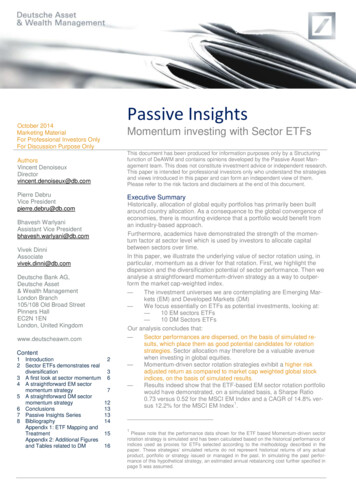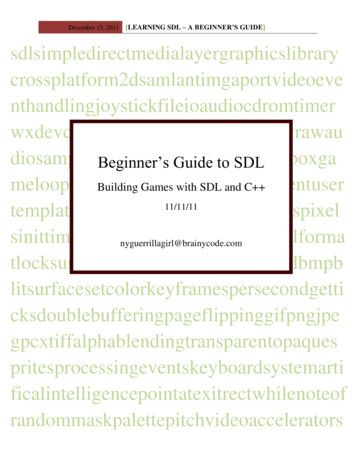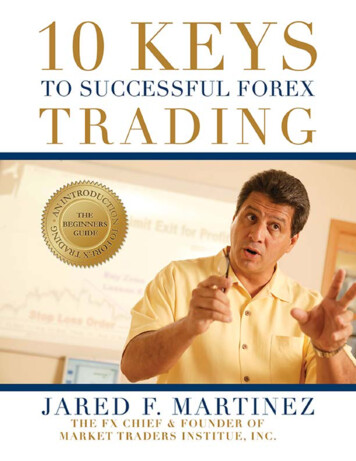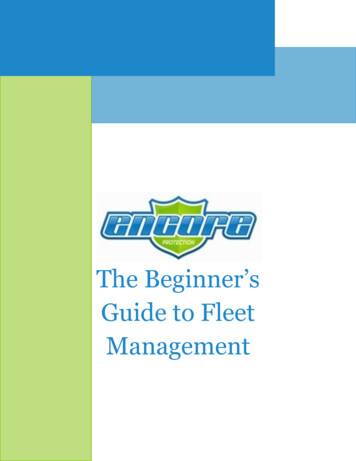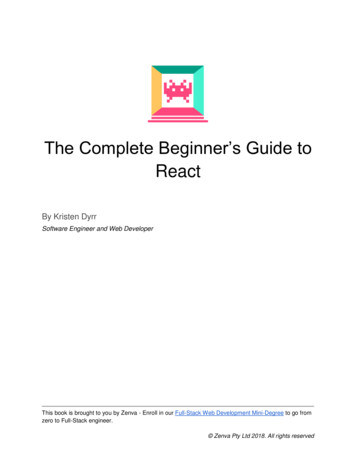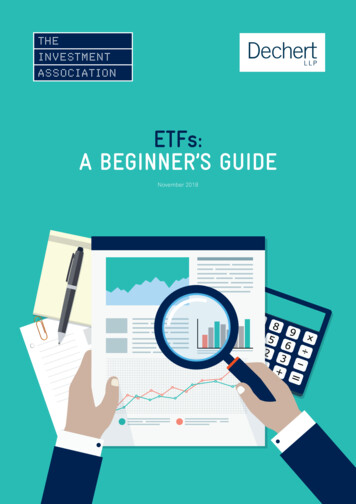
Transcription
ETFs:A BEGINNER’S GUIDENovember 2018
The purpose of this guide is to provide an introductory guide to exchange traded funds (“ETFs”) inEurope. We note that this guide has been made available to the public and is informational only andshould not be treated as legal advice.This guide does not constitute professional advice of any kind and should not be treated asprofessional advice of any kind. No person should act upon the information contained in this guidewithout obtaining specific professional advice. The Investment Association (the “IA”) accepts no duty ofcare to any person in relation to this guide and accepts no liability for your reliance on the guide.All the information contained in this guide was compiled with reasonable professional diligence,however, the information in this guide has not been audited or verified by any third party and is subjectto change at any time, without notice and may be updated from time to time without notice. The IAnor any of its respective directors, officers, employees, partners, shareholders, affiliates, associates,members or agents (“IA Party”) do not accept any responsibility or liability for the truth, accuracy orcompleteness of the information provided, and do not make any representation or warranty, express orimplied, as to the truth, accuracy or completeness of the information in this guide.No IA Party is responsible or liable for any consequences of you or anyone else acting, or refrainingto act, in reliance on this guide or for any decision based on it, including anyone who received theinformation in this guide from any source and at any time including any recipients of any onwardtransmissions of this guide. Certain information contained within this guide may be based on orobtained or derived from data published or prepared by third parties. While such sources are believedto be reliable, no IA Party assumes any responsibility or liability for the accuracy of any informationobtained or derived from data published or prepared by third parties.Should you need further assistance then please feel free to reach out to your usual InvestmentAssociation contact. We thank Dechert LLP for its assistance in the review of this guide.
THE ETF LANDSCAPEETFs were first introduced approximately 25 years ago in Canadaand the United States. Since then they have grown into a majorportion of global capital markets, representing 4.8 trillion inglobal Assets Under Management (AUM)1. This is up from just 417bn in 20052.The US remains the largest regional ETF market,with approximately 3.65 trillion in AUM as ofJanuary 2018. Europe is the second largest ETFmarket, with approximate AUM of 850bn, followedby the Japanese and Asia-Pacific markets. Canada,Latin America, South Africa and the Middle Eastalso offer investors a variety of ETF products.Equity-based ETFs make up a considerablemajority of ETF products. However Fixed Incomebased ETFs have grown significantly in recentyears and now form a very material part of themarket. 4.8trnin globalAUMEurope 850bnin AUMUS 3.6trnin AUM12 BlackRock Global Business Intelligence, as of 31 March 2018EY’s Global ETF Research 2017 reportTHEINVESTMENTASSOCIATION.ORG 3
WHAT IS AN ETF?An exchange-traded fund (“ETF”) is an investmentfund (commonly aiming to track an index) whereshares in the investment fund are traded on astock exchange(s) and can be bought or sold byinvestors at the current market price throughouttrading hours (i.e. it allows for “intra-day” trading).sell shares in the ETF. This differs from traditionalinvestment funds which may only provide for directsubscriptions and redemptions of their shares ona periodic basis based on their net asset value(“NAV”) and so do not normally provide for intraday trading.Typically, shares in an ETF itself may only bedirectly subscribed for or redeemed with theETF itself through an intermediary financialinstitution known as an Authorised Participant(“AP”). Subscriptions and redemptions of an ETFare usually effected in large blocks of sharesknown as “baskets” by APs. Alongside the officialmarket makers for an ETF, APs will make marketsin and distribute the ETF within the secondarymarket (i.e. the stock exchange), through whichinvestors (including retail investors) may buy andThough similarly named, ETFs should not beconfused with other forms of exchange tradedproducts (ETPs), such as exchange traded notes(“ETNs”) or exchange traded commodities (“ETCs”).ETPs, which are also traded on exchange, aresubject to different regulatory frameworkscompared to ETFs and often would carry differingstructural and risk characteristics to that of an ETF.an investment fundwhere shares in theinvestment fund are tradedon a stock exchange(s)and can be bought or soldby investors at the currentmarket price throughouttrading hours.4 ETFS: A BEGINNER’S GUIDE
HOW ARE ETFsREGULATED IN EUROPEETFs in Europe may be established either incompliance with the Undertakings for CollectiveInvestment in Transferable Securities (“UCITS”)directive, in which case they must then beidentified with the “UCITS ETFs” label in their name;or the alternative investment managers’ directive(“AIFMD). Very many of the ETFs established inEurope are UCITS ETFs; consequently they benefitfrom, and are subject to, the robust regulatoryenvironment and safeguards which comes fromthe UCITS directive.European ETFs are often subject to a widevariety of laws and regulation, ranging from rulesregarding their establishment and daily operationsto regulations relating to the use of benchmarksand finally laws setting out how ETFs may bemarketed, distributed and sold across Europe. R isk management and tolerancelevels for UCITS ETFs, includingguidance related to managingcounterparty risk and conflictsof interests Collateral management A bility to redeem UCITS ETF on the primarymarket at NAV if the secondary market is nolonger available (e.g. if an AP defaults) D isclosure and reporting requirements forUCITS ETFs and ETFs, including specificrequirements for active ETFs.European regulation allows UCITS ETFs to track anindex (as a passive strategy) or an active strategy.Nevertheless most of European ETFs follow anindex-based strategy and active ETFs are not sopopular.In addition, physical European ETFs will benefitfrom regulatory safeguards created by theSecurities Financial Transactions Regulation (SFTRegulation), which provides greater information onsecurities lending and OTC derivatives trades. Forsynthetic ETFs, the EMIR regulation limits the risklinked to OTC derivatives, with central clearing forsome derivatives and/or risk mitigation techniquesfor others.Together, these set out provisions relating tothe following for an ETF established and sold inEurope:Each individual ETF will also be subject to theappropriate exchange rules in each jurisdiction inwhich the ETF is listed. E ligibility requirements for inclusion in a UCITSETF portfolio, assets diversification rules andlimitations on illiquid assets D iversification rules for indices used by aUCITS ETFThere has also been scrutiny applied on ETFsmore generally at a global level, including thepublication of the International Organization ofSecurities Commissions (“IOSCO”) Principles forthe Regulation of Exchange Traded Funds in 2013. R egulations for ETFs using Benchmarks totrack an index3 his includes, as applicable, adherence to: the UCITS Directive, the Eligible Assets Directive, the Prospectus Directive, the Benchmark Regulation and MiFID II. In addition,Tspecific guidance has been provided for UCITS ETFs by ESMA’s Guidelines on ETFs and other UCITS Issues.THEINVESTMENTASSOCIATION.ORG 5
WHAT IS THE SOURCE OF PROFITAND THE RISK OF LOSS?THE PRINCIPAL WAY OF GENERATINGRETURNS – ETF INDEX REPLICATIONETFs will typically look to track an index. It is theperformance of that index which provides thebroad nature of the investors’ experiences of gainsor losses. There are three ways in which ETFs canlook to replicate an index. As with any investment,indices can go down as well as up and so trackingan index may lead to losses.Full physical replicationAll securities within an index are purchasedaccording to their weightings, in order to ensurea minimal tracking error. This method may not bepossible for illiquid indexes, and may be costlywhere an index consists of a large number ofsecurities. As a result physical replication is usedmostly for liquid and/or narrowly defined indexes.Physical ETFs may also carry out securitieslending, which generates incomes for the fund butcreates some counterparty risk. A strict securitieslending policy (with an appropriate counterpartiesand collateral management) is required at thoseETFs in order to appropriately manage such risk.6 ETFS: A BEGINNER’S GUIDEOptimised physical replicationThis replication is also called as “samplingreplication”. This is where a limited number ofsecurities are considered, in order to create anETF that broadly reflects, but does not fully track,a given index. There will be inevitable trackingerror using this method, but optimisation looksto ensure that these deviations are low andcontrolled while looking to eliminate economicallyunattractive securities. This method is used mostlyfor indexes with illiquid investments and broadbased indexes.So-called “optimised” physical ETFs may alsocarry out securities lending, which generatesincomes for the fund but creates somecounterparty risk. A strict securitieslending policy (with an appropriatecounterparties and collateralmanagement) is required atthose ETFs to appropriatelymanage such risk.
Synthetic replicationKnown also as “unfunded swap-based ETFs”,synthetic replication involves the use ofderivatives, such as total return swaps. Underthis structure the ETF uses the investor’s cash tobuy a “substitute basket” of securities. The fundsimultaneously enters into one or several swapagreements with one or several counterpartiesthat commit to deliver the reference index’sperformance (plus securities lending revenuesgained on the lending of the index components,less swap fees if any) in exchange for theperformance of the securities purchased andsubsequently held by the fund.Synthetic ETFs do not lend their assets butthey generate counterparty risk through theuse of the swaps (from their reliance on thebank counterparties remaining solvent andable to meet their obligations under the swapcontracts). Controls at these ETFs are designed toappropriately manage such counterparty risk.OTHER WAYS OF GENERATINGRETURNS – SECURITIES LENDINGETFs will sometimes engage in securities lending,wherein securities held by the ETF are loaned toanother investor or form. Securities are commonlylent temporarily to other market participants whomay need them for a variety of their own reasons.A market participant needing shares or othersecurities may approach an ETF to borrow themtemporarily. In return, the ETF will receive a fee,and a borrower must also post collateral. The ETFwill often receive payments equal to the dividendsreceived over the security during the time it is heldby the borrower.Securities lending can generate significantrevenue for an ETF. This income generated istypically used to offset the index replication costsand thus allows the fund to have a performanceas close as possible to the benchmark index.Nonetheless, ETF securities lending does bringwith it counterparty risk, in the event that aborrower defaults in returning the securities at theend of the loan period.ACTIVE ETFsWhilst historically ETFs tracked well-knownindices, there are some ETFs in which a portfoliomanager will exercise discretion over what to buyor sell, outside of following an index. These activelymanaged funds are presently a minority; currentregulatory debate is over the extent to which activeETFs should reveal their holdings on a daily basis(see below), many active ETFs do.THEINVESTMENTASSOCIATION.ORG 7
KEY CHARACTERISTICS FOR INVESTORS1. TRANSPARENCY3. DIVERSIFICATIONETFs have a clear investment objective andtransparency of unit price; along with continuoustrading this can be helpful to some investorsduring volatile market conditions.ETFs aim to offer investors easy and immediateexposure to a basket or group of securities fordiversification through a single trade. ETFs canalso accommodate a broad range of asset classes,including equities, bonds, commodities andmore. Historically ETFs commonly tracked majorindices (mainly based on market capitalisations)Nowadays there is a wider range of indices basedon single or multi “factors” (Smart Beta indices) toprovide greater choice.2. COST-EFFECTIVENESSETFs aim to offer investors a cost-effective routeto diversified market exposure, not least becauseas with other collectives, an investor can benefitfrom scale management and lower transactioncosts than could be expected were each underlyingsecurity bought by an individual. Investors haveaccess to a diversified market exposure thanksto one trade. Most ETFs, although not all, alsofollow passive index-tracking strategies which willbe reflected in their management fee levels. EUUCITS ETFs sold in the UK are subject to the sametax treatment as other EU UCITS funds sold here(though in all cases, for ETF or other funds, investorswill need to consider the specific situation).8 ETFS: A BEGINNER’S GUIDE4. FLEXIBILITYBecause ETFs are tradeable on stock exchanges,investors can buy or sell ETF shares at any timeduring trading hours. As a result ETFs provide alevel of flexibility distinctive from more traditionalmutual funds which have once-a-day trading.Due to the investor usually being able to trade onthe market with willing buyers and sellers, ETFsthemselves do not require notification of largeinvestments or withdrawals, or holding periodcommitments or minimum fees, so reducing othereconomic costs that might reduce the value of aninvestor’s holding. Finally, ETFs can be created orredeemed by APs delivering or receiving basketsof securities, which may provide additionalinvestment options, though investors invariablyrealise their investments by trading on thesecondary market and not by redeeming with thefund – this is more for market makers.
5. LIQUIDITYETFs could be described as offering three levels ofliquidity:1. Traditional liquidity as measured by secondarymarket trading volume. It is the most visiblesource of the ETF liquidity but it may reflectonly a small part of the liquidity. ETFs with hightransaction volumes may at times exhibit greatersecondary market liquidity than their underlyingholdings.2. The liquidity that is measured by the blocktrades negotiated by market makers and APs onsecondary market that does not go through theexchange/on-screen. Authorised participants postbid-and-offer prices on the exchange, enhancingliquidity still further. As APs typically only displaya small fraction of the volume they are willing totrade, secondary market ETF liquidity is often fardeeper than it initially appears.3. Finally there is the liquidity offered by unitcreation based on the underlying securitiesthrough the creation/redemption mechanism.This is the so-called liquidity of the index that isequal to the liquidity of the index components. Itis the biggest source of liquidity. APs can offsetan increase in demand by creating more units,or offset a decrease in demand by redeemingunits. As long as there is enough liquidity on theETF underlying components, new ETF sharescan be created through the creation/redemptionmechanism.However there are risks to liquidity arising from theuse of APs and the fact that prices for the shares inETFs can move away from the underlying net assetvalue of the share as calculated daily – thougharbitrage activity can be expected to correct this.Given the continuous trading that can occur intheir shares, ETFs aim to provide an additive levelof liquidity compared to that normally offered bymutual funds. Whilst in commonly experiencedmarket conditions, the dealing mechanism aimsto provide the level of liquidity that investors mightwant from a continuously traded investment,liquidity can never be guaranteed.KEY RISKS OF ETFsThere are risks associated with ETFs, as for anyother investment product. Those risks are linkedto the index components: for example market,currency, counterparty, credit, interest rate,liquidity, replication, operational risk etc. All risksrelated to the ETF are disclosed and explained inthe ETF legal documentation.Like other traditional funds, during stressedmarket conditions, it is possible that the basketof underlying securities may no longer be readilytradable. In extreme circumstances there may beincidences where it becomes necessary for theETF to become ‘closed-ended’ (meaning it is notcreating new shares or redeeming old ones) untilmarket conditions return to normal or the fund canbe liquidated. Short and leveraged ETFs bring theirown particular risks as well.As listed products, spreads may widen duringperiod of market volatility, and the value of an ETFinvestment may go down as well as up.THEINVESTMENTASSOCIATION.ORG 9
ANNEX BUY AND SELLING SHARES IN AN ETFTHE ROLE OF AN AUTHORISED PARTICIPANT (AP)The main role of the AP is to interact directly withthe ETF provider to create and redeem units withinthe ETF – this is known as primary market trading.Most APs will facilitate creations or redemptionson behalf of clients. The trades can also be onbehalf of market makers who provide pricing andliquidity on exchange – this is known as secondarymarket trading.10 ETFS: A BEGINNER’S GUIDEAPs can be financial institutions or market makers.An AP does not have to be a market maker and amarket maker does not need to be an AP. Generallyyou will find that most market makers are APs asthey will need to create and redeem in the primarymarket after trading in the secondary market; forexample if they go short the ETF and have to createto cover the short position.
CREATIONS AND REDEMPTIONSA key feature of ETFs is the creation andredemption mechanism, the primary marketactivity which allows ETFs to grow or contractbased on investor demand.ETF shares are created when an AP supplies cashor a specified basket of securities (known as the‘creation basket’) to the ETF issuer and receivesa specified number of ETF shares, known as a‘creation unit’, in return. The AP can then sell ETFson the secondary market.The redemption process is the reverse transaction.The AP returns the creation unit to the ETF, and inreturn receives a ‘redemption basket’ or cash. Thevalue of the redemption basket will be equivalentto the value of the creation unit based on the ETF’send-of-day NAV.As well as providing additive liquidity, the creation/redemption mechanism helps keep the marketprice of an ETF close to its NAV. This is because ifan ETF share is trading at a premium or discount, itoffers an arbitrage opportunity to APs.If an ETF is trading at a premium to its NAV, theAP can buy the ETF’s underlying securities, supplythem as a creation basket to an ETF issuer, receivea creation unit of ETF shares, and sell those sharesin the secondary market for a profit. In turn this willhelp bring the ETF’s secondary market price backin line with its NAV.If an ETF’s shares are trading at a discount to itsNAV, the AP can do the reverse, by selling the ETF’sconstituent securities, buying ETF shares in theopen market, and then returning the shares tothe fund in exchange for the redemption basket ofsecurities and/or cash. This also brings the ETFsprice back in line with the NAV.FIGURE 1: CREATION AND REDEMPTION PROCESS, AND INTERPLAY BETWEEN PRIMARY ANDSECONDARY MARKETSSECONDARY MARKETSPRIMARY MARKETSCREATIONINVESTOR BUYS/SELLSCreation basket/cashETF sharesETFCreation UnitCreation UnitETF sharesTRADING INVESTMENTASSOCIATION.ORG 11
The Investment AssociationCamomile Court, 23 Camomile Street, London, EC3A er 2018 The Investment Association (2018). All rights reserved.No reproduction without permission of The Investment Association.
trading hours (i.e. it allows for “intra-day” trading). Typically, shares in an ETF itself may only be directly subscribed for or redeemed with the ETF itself through an intermediary financial institution known as an Authorised Participant (“AP”). Subscriptions and redemptions
